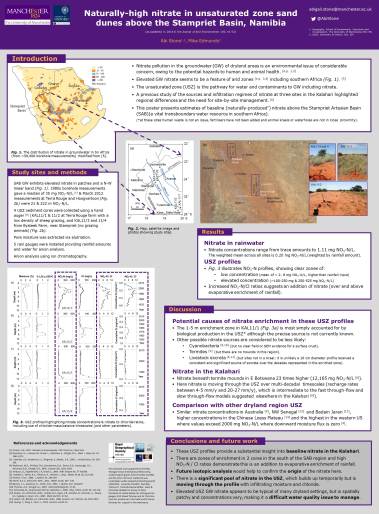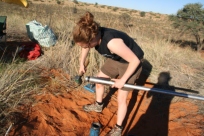It was whilst investigating how much rainfall seeps down through desert dunes down to groundwater supplies in the Stampriet Aquifer Basin in southern Namibia that I and my late co-author Mike Edmunds also discovered elevated levels of nitrate in the moisture within the dunes (see Stone and Edmunds, 2012; 2014). When I say elevated levels of nitrate, concentrations of nitrate were up to 100-250 mg/L and 250-525 mg/L (expressed (NO3-N), nitrate as nitrogen (see note 1)) in two sand dune profiles. See the graphs on the poster below, or have a look at Figure 4 in Stone and Edmunds, 2014. This is newsworthy, and of concern, because these levels of nitrate represent poor water quality. The WHO (World Health Organisation) state a maximum safe limit for nitrate in drinking water of 11.3 mg/L NO3-N. This means were are finding levels 10 to 50 times higher than this safe limit. So why is this a problem? Well, nitrate is both toxic to, and readily absorbed by, humans and animals (see note 2).
We had already discovered that water from rainfall was moving through the dunes at a significant, and quantifiable, rate of between 4-5 mm/y and 20-27 mm/y (representing between 1 and 14% of mean annual rainfall in the area) (see note 3). This means that these high concentrations of nitrate are also advancing toward the vital groundwater supplies at a significant rate, reaching the base of 12 m high dunes in around 20 to 60 years.
This provides us with a strong incentive to understand how widespread these elevated levels of nitrate are, and wh ere they are originating from. From an assessment of the setting itself, we suggested in 2014 that a natural origin was most likely. The land-owner in this region does not add any fertilisers to the land and uses the land for low density sheep grazing. We considered that a source from the sheep (their urine and faeces) was unlikely, owing to (i) the sampled sites being well away from animal enclosures and (ii) the depth of elevated nitrate within the profile representing accumulation of nitrate over a timescale of decades. It seems too improbable that a sheep, or collection of sheep, would select a 10 to 20 cm diameter target on the top of one dune as a long-term latrine! Our most probable explanation remains a source from N-fixing vegetation. In the Kalahari, such N-fixing forms of vegetation include Acacia trees and grasses (such as Stipagrostis amabalis, Schmidtia kalihariensis and Arstida congesta). Whilst the sites we sampled are not close to Acacia trees, there are some grass species present.
ere they are originating from. From an assessment of the setting itself, we suggested in 2014 that a natural origin was most likely. The land-owner in this region does not add any fertilisers to the land and uses the land for low density sheep grazing. We considered that a source from the sheep (their urine and faeces) was unlikely, owing to (i) the sampled sites being well away from animal enclosures and (ii) the depth of elevated nitrate within the profile representing accumulation of nitrate over a timescale of decades. It seems too improbable that a sheep, or collection of sheep, would select a 10 to 20 cm diameter target on the top of one dune as a long-term latrine! Our most probable explanation remains a source from N-fixing vegetation. In the Kalahari, such N-fixing forms of vegetation include Acacia trees and grasses (such as Stipagrostis amabalis, Schmidtia kalihariensis and Arstida congesta). Whilst the sites we sampled are not close to Acacia trees, there are some grass species present.
One good way to better constrain the potential source(s) of nitrate is to measure the isotopes of nitrogen (N) and oxygen (O) in the nitrate. This allows us to identify contributions from the atmosphere, fertiliser, manure/sewage and soil (with some overlap between manure and soil). The presence of nitrate in soil occurs by fixation of nitrogen by bacteria in the nodules of vegetation roots, or by cyanobacteria, or within the guts of termites.
For this reason I am working with the NIGL (that’s the Natural Environmental Research Council Stable Isotopes Facility) to measure the isotopic composition of the nitrate in my samples. The project ‘Nitrate beneath the surface in drylands’ involves a phase of fieldwork in March-April 2016 to collect fresh samples, funded by the University of Manchester, and analysis that I will undertake with Tim Heaton, Angela Lamb and Andi Smith in Keyworth, which is funded by NIGL.
We will be providing detailed analysis of nitrate across a 10 km by 5 km region of the southern Kalahari above the Stampriet Artesian Basin, with around 12 to 15 profiles through the dune sediments collected. Samples will be taken at at least 50 cm vertical resolution down to 12 m depth to build up a detailed picture of the origin and transport of the nitrate down toward the groundwater table.
This research will help to fill a gap in understanding between the production of nitrate in drylands as part of the nitrogen cycle in the surface soil-plant system, and the presence of high nitrate concentrations in the groundwater supplies. We have very little understanding of what happens to nitrate between the surface soil and groundwater. And as outlined above, the stable isotope analysis will help us to constrain the origin of these high nitrate concentrations from a range of possible sources, including those that can be considered a natural baseline and those that constitute anthropogenic pollution. This is important for effective land-use and groundwater resource management.
Watch this space for updates to the field campaign, where I will be collecting sediment profiles through the sand dunes, and samples of water from boreholes with the assistance of dryland environmental PhD student, Jerome Mayaud.
Sampling the Kalahari sand dunes in 2013.
——–
Note 1: It is a common convention to express nitrate (an anionic form of nitric acid as a salt) as an equivalent value of nitrogen (the chemical element N). For example, the WHO (World Health Organisation) use this way of expressing the concentration of nitrate, and they state a maximum limit for nitrate in drinking water of 11.3 mg/L NO3-N.
Note 2: The health hazards of ingesting too much nitrate include gastrointestinal disorders in the short term. In the long-term it is carcinogenic, and causes a blood disorder methemoglobinemia. See the WHO background document for more information http://www.who.int/water_sanitation_health/dwq/chemicals/nitratenitrite2ndadd.pdf
Note 3: Discovering that rainfall was making it through the dunes and contributing to recharge of groundwater supplies was a significant finding in itself. If we want to be able to assess the sustainability of groundwater resources we need good date on the input of water (recharge) in addition to the outputs (utilisation). Direct recharge through the dunes is a pathway in addition to the well-defined focused recharge pathways through sinkholes in a calcrete surface to the north and north-west of the basin.
Related research publications (please email me for further details)
Stone, A. E. C., Edmunds, W. M. (2014) Naturally-high nitrate in the unsaturated zone sand dunes above the Stampriet Basin, Namibia. Journal of Arid Environments 105, 41-51.
Stone, A. E. C. and Edmunds, W. M. (2012) Sand, salt and water in the Stampriet Basin,Namibia: Calculating unsaturated zone (Kalahari dune-field) recharge using the chloride mass balance approach.Water SA 38(3), 367-377.



